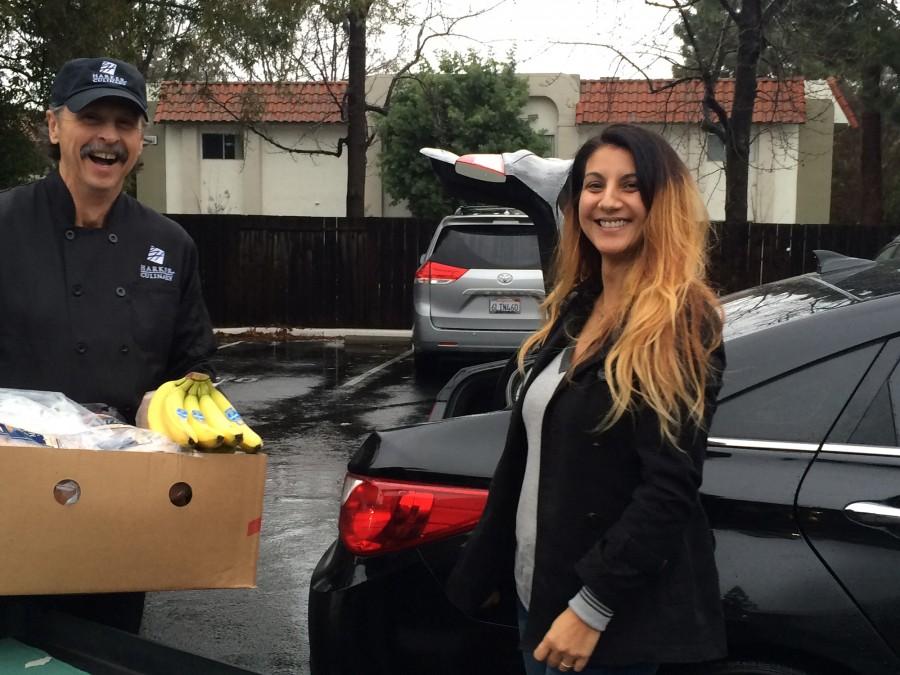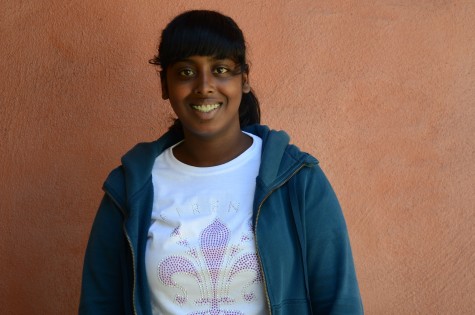Reuse, recycle, reheat: kitchen staff donates uneaten food
Chef Steve gives a box of excess food for donation to a shelter for homeless children. Food is donated at the end of each week.
January 29, 2016
For most members of the Harker community, the highlight of the day is lunch. During fifth or sixth periods and long lunch, students and teachers pack into the Edge to get their hands on the kitchen’s latest creations. While the dishes are popular amongst many, not all of the food is ever entirely consumed. With this, the kitchen staff has devised several efficient means of utilizing the leftovers.
One way the kitchen staff conserves resources is by reusing the leftover foods as ingredients for future meals. According to executive director of food services Callie Stanley, the cooks repurpose the food that the students could not finish into delectable foods to be enjoyed the next day.
“If we have any pasta left over on the pasta station, we’ll cool it down, and then on the next day we will make a pasta salad out of it,” she said. “If we have chicken on the carving station or in the main window, we could cool that down and make a chicken salad. In the same way, last week we had some garbanzo beans left over so we put it into a soup the next day.”
Usually, the staff batch-cooks on days with both fifth and sixth period lunches, so they aren’t left with a large amount of extra food.
“On the two lunch days, we’ll cook in between to see how much we have left from the first lunch and then just cook what we need for the second lunch,” Stanley added.
On Fridays, the kitchen staff donates their leftovers to The Village, a local homeless shelter for children in San Jose, California, as the food cannot be reused for Harker students the next day. They contact Michele Cabania, the manager of the shelter, pack the food in to-go boxes, and send them away as meals for those in need.
Chef Steve Martin explains the process in which the food is delivered to those in need.
“Once a month, we prepare boxed lunches for 25 children,” he said. “[The organization] is called Stand Up for Kids. They are homeless kids that are part of this program, which places them homes and tries to give them mentoring. Ideal is once a month, we supply the children with one meal a month. Probably there are 20 other companies that do the same thing.”
Stand Up for Kids opened The Village in 2014, so children could eat warm meals, take showers, use computers and phones, receive new clothes, and talk with counselors to come up with a plan to improve their lives.
The process of donating to the shelter, however, is quite a recent establishment.
“It’s pretty recent and it’s been about a year since we started on this– probably the end of previous school year or the beginning of this school year,” he said. “So, it’s once a month and about 9 months ago, maybe.”
The homeless shelter does not follow San Jose nutrition guidelines, as they accept any sort of food to sustain their youth. However, the high-quality upper school meals already meet the city’s nutrition standards.
Martin strongly believes that this philanthropic means of repurposing the food is embraced by all members of the kitchen staff as well as the head of the school.
“It’s food that’s probably going to go waste, and it’s a great cause to take care of homeless children,” he said. “It’s an amazing cause. I was approached by one of the directors and I went up to Mr. Nickloff, and he said absolutely.”
This piece was originally published in the pages of the Winged Post on Jan. 27, 2016


















![“[Building nerf blasters] became this outlet of creativity for me that hasn't been matched by anything else. The process [of] making a build complete to your desire is such a painstakingly difficult process, but I've had to learn from [the skills needed from] soldering to proper painting. There's so many different options for everything, if you think about it, it exists. The best part is [that] if it doesn't exist, you can build it yourself," Ishaan Parate said.](https://harkeraquila.com/wp-content/uploads/2022/08/DSC_8149-900x604.jpg)




![“When I came into high school, I was ready to be a follower. But DECA was a game changer for me. It helped me overcome my fear of public speaking, and it's played such a major role in who I've become today. To be able to successfully lead a chapter of 150 students, an officer team and be one of the upperclassmen I once really admired is something I'm [really] proud of,” Anvitha Tummala ('21) said.](https://harkeraquila.com/wp-content/uploads/2021/07/Screen-Shot-2021-07-25-at-9.50.05-AM-900x594.png)







![“I think getting up in the morning and having a sense of purpose [is exciting]. I think without a certain amount of drive, life is kind of obsolete and mundane, and I think having that every single day is what makes each day unique and kind of makes life exciting,” Neymika Jain (12) said.](https://harkeraquila.com/wp-content/uploads/2017/06/Screen-Shot-2017-06-03-at-4.54.16-PM.png)








![“My slogan is ‘slow feet, don’t eat, and I’m hungry.’ You need to run fast to get where you are–you aren't going to get those championships if you aren't fast,” Angel Cervantes (12) said. “I want to do well in school on my tests and in track and win championships for my team. I live by that, [and] I can do that anywhere: in the classroom or on the field.”](https://harkeraquila.com/wp-content/uploads/2018/06/DSC5146-900x601.jpg)
![“[Volleyball has] taught me how to fall correctly, and another thing it taught is that you don’t have to be the best at something to be good at it. If you just hit the ball in a smart way, then it still scores points and you’re good at it. You could be a background player and still make a much bigger impact on the team than you would think,” Anya Gert (’20) said.](https://harkeraquila.com/wp-content/uploads/2020/06/AnnaGert_JinTuan_HoHPhotoEdited-600x900.jpeg)

![“I'm not nearly there yet, but [my confidence has] definitely been getting better since I was pretty shy and timid coming into Harker my freshman year. I know that there's a lot of people that are really confident in what they do, and I really admire them. Everyone's so driven and that has really pushed me to kind of try to find my own place in high school and be more confident,” Alyssa Huang (’20) said.](https://harkeraquila.com/wp-content/uploads/2020/06/AlyssaHuang_EmilyChen_HoHPhoto-900x749.jpeg)













Maldo. Maldonado • Jun 14, 2016 at 12:38 am
I just wanted to say macheal is a angle, one of a kind,world needs more angles like her!!! Sincerely Maldo .